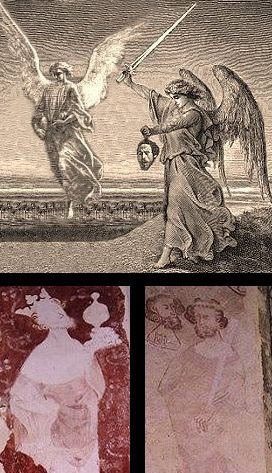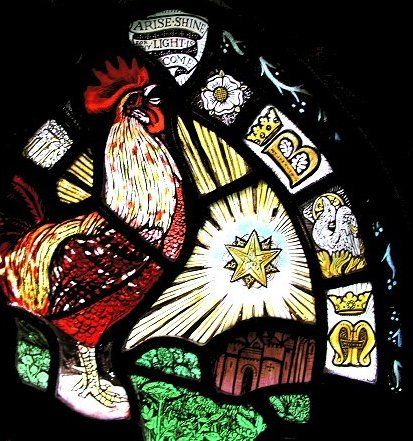Page 10 of 12
The Templars and the Ark of the Covenant
The Epiphany Code
The Epiphany Window donated to Langley Chapel by Cove-Jones in 1907. (Click on image for larger photo)

The angels Gabriel and Michael and the Burton Dasset murals.
Langley is a leafy village, a few miles north of Stratford-upon-Avon and Jacob Cove-Jones’ stained-glass window can still be seen in its tiny parish church. When Graham and the Russells first visited the building they expected the window to depict an Old Testament scene but instead it showed a scene from the New Testament - the Epiphany. The Epiphany is the twelfth night of Christmas, on January 6, when the Three Wise Men are said to have visited the baby Jesus. Called the Epiphany Window, the stained-glass scene showed the Wise Men with their gifts before the Christ Child in the Bethlehem stable where the Bible says Jesus was born.
Eventually Graham and the Russells concluded that if the window did hold a coded message to lead to “a discovery of immense importance”, as Cove-Jones claimed, then it had to have something to do with a star. According to the New Testament, a strange new star appeared in the sky at the time of Jesus’ birth. Somewhere to the far east of Judea, the three Wise Men believed that the star was a sign from God to reveal the birthplace of the Messiah. They traveled in the direction of the star until they reached Bethlehem. The story concerned a place being found by following a star. Could a star somehow be involved in leading to the whereabouts of the Templars’ treasure? In fact, the stained-glass window appeared to show two stars, one on overlaid on the other.
If Graham’s theory was right then the Templars’ treasure included the Ark of the Covenant and there were two stars fundamentally associated with the Ark. These were the two tail stars of the Big Dipper, now called Benetnash and Mizar, which to the ancient Israelites represented Michael and Gabriel, the guardian angels depicted on the lid of the Ark. Indeed, this tied up with the figures portrayed in the murals to either side of the window in Burton Dassett Church. Gabriel was bringer of enlightenment and God’s message and was often depicted with a vessel containing the sacred water of God’s salvation, while Michael was the instrument of God’s wrath, often depicted with severed heads of the Lord’s enemies. One of the figures in the Burton Dassett murals held a chalice and the other a severed head. Even though they were depicted as medieval kings, this was surely more than coincidence. Perhaps they represented the two archangels of the Ark. Maybe either or both of the Big Dipper stars they were associated with somehow indicted the secret hiding place.
However, if Jacob Cove-Jones had used these stars to indicate a hiding place, Graham and the Russells would need to know where and when they should be observed. The positions of the stars change all the time, not only in relation to the rotation of the earth, but also throughout the course of the year as the earth orbits the sun. If the treasure was hidden somewhere that was, for instance, indicted by the stars directly above it, they would need to know the precise time and day of the year to observe them. Furthermore, they would need to know where to observe the stars from, as they would appear to be over different locations depending on the viewing point.
Graham and the Russells eventually came up with a solution. At the top of the Epiphany Window there was the star which guided the Wise Men to Bethlehem. In fact, it appeared to be two stars, one overlaid on the other. And right next to it there was a phoenix rising from flames – the very same creature after which the Burton Dassett Hills had originally been named. Could the location from which to observe these stars be the top of the Phoenix Hills? In fact, on top of these hills there stood the Phoenix Beacon, erected by the Templars themselves, which bore a striking resemblance to the central image in the stained-glass window: the odd-shaped casket held by one of the Wise Man. It looked very much like the round tower, with its peculiar, conical roof and castellated walls. The casket even had a bird upon it that seemed to be another representation of the phoenix rising from the fire. When Graham and the Russells realized that the panels either side of the phoenix image beside the star were decorated with the letters B and M, they were convinced that the Phoenix Beacon was where they should observe the stars. These were the initials of the two tail stars of the Big Dipper - Benetnash and Mizar.
The final question was when they should observe these stars. Ultimately they decided that the answer lay in the name of the window and the event it depicted – the Epiphany on the 6 January. There was only one thing left: at what time on that night should they observe the stars? Something in the window did provide a precise hour of the day. At the very top of the window there was a cockerel, which in Christian tradition crowed at midnight to reveal to the Wise Men the precise whereabouts of the stable where Jesus had been born, once the star had led them to Bethlehem. If they were right then midnight on January 6 appeared to be the precise time they needed to be on top of the Burton Dassett Hills.

The scene at the top of the Epiphany Window showing a cockerel, star, a phoenix, and the letters B and M.
The Epiphany Window's central casket image and the Phoenix Beacon on the Burton Dassett Hills.









